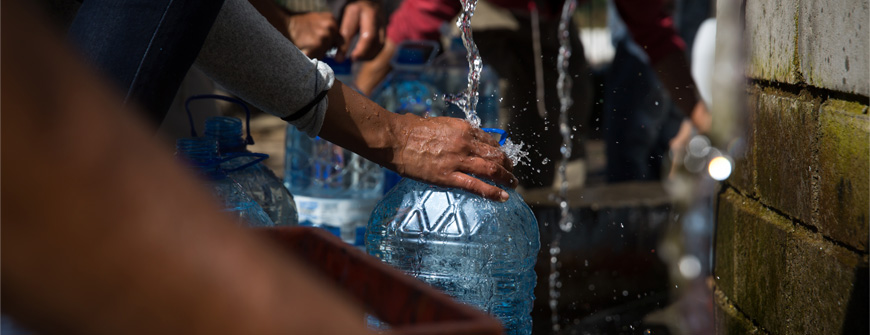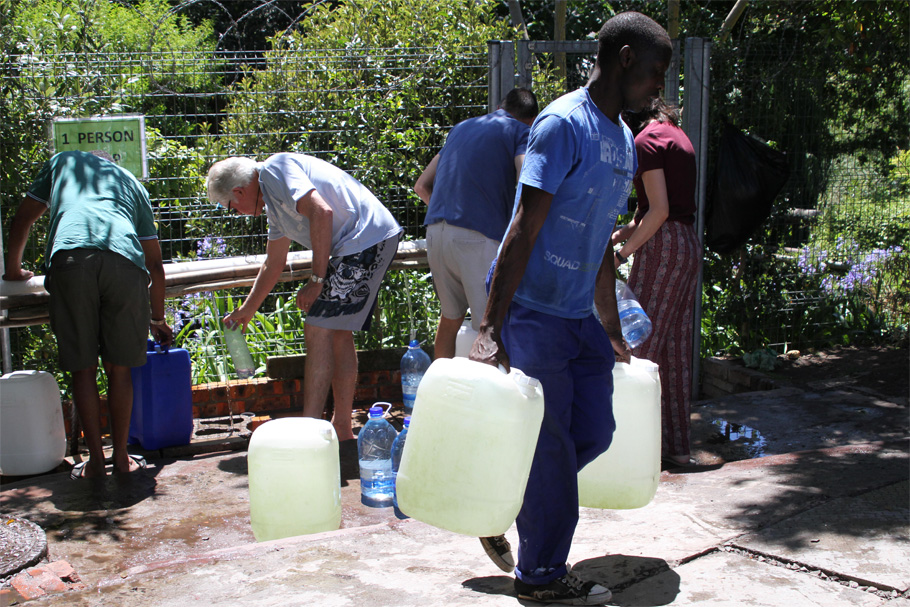LIXIL makes pioneering water and housing products that solve everyday, real-life challenges, making better homes a reality for everyone, everywhere.
- Global Site
-
- English
- Japanese
- Brand Sites
Global
- Global Site
-
- English
- Japanese
- Brand Sites

Updated: Mar 22, 2018
Cape Town resident Kirsty Alberts washes her family's bed linen once every two weeks and toilets at home are only flushed once or twice a day, when absolutely necessary. Carla dos Santos limits herself to two minutes under the shower and her garden has turned brittle and brown because it can no longer be watered. Robbie Webb's gym collects run-off from the showers to flush the toilets and a dip in the pool is a thing of the past.
This, to the people of Cape Town, is the "new normal" as the city at the very southern tip of the African continent grapples with a three-year drought that has triggered the most severe water crisis in living memory.
According to local officials1, the reservoirs that feed the city's approximately 433,000 residents were down to 25 percent of their capacity as of February 2018 and, if water levels continue to decline, then taps in the modern metropolis could run dry as early as August.2
"It is hard to remember when we first became aware of the water crisis and began to change our behavior," said Alberts, 34, who studies at Stellenbosch University and lives in the Cape Town suburb of Blouberg. Even though her family has modified its water consumption "dramatically," Alberts says the situation is "dire."

Residents filling up 25 liter containers at a natural spring in Cape Town
Cape Town has implemented a range of stringent measures to ease the problem.
Jane Reddick, of Cape Town's Department of Water, said measures designed to reduce consumption have so far started to have an effect. "Consumption can very easily be monitored at the level of individual residences. It is clearly detailed in their monthly rates account, with totals for each month and the average number of liters used per day," she said. That figure is set at a maximum of 50 liters per person per day, with severe fines imposed for properties that still ignore the restrictions.
Cape Town's domestic water consumption now stands at about 510 to 520 million liters per day, down 60 percent compared to the 1.2 billion liters consumed per day in February 20153.
But while the crisis in Cape Town is happening now, there are many other cities around the world that have concerns about supplies of safe, drinkable water. A survey4 conducted in 2014 of over 500 of the world's cities estimates that one in four are experiencing "water stress," while UN projections5 indicate that global demand for fresh water will outstrip supply by as much as 40 percent in 2030 as a result of a combination of climate change, human action and population growth.
And the problem is not just confined to arid and semi-arid regions. The list of major cities identified as being water stressed includes Moscow, Beijing, London, Rio de Janeiro, Los Angeles and Tokyo6.
 Low water levels at the Theewaterskloof Dam outside Cape Town
While the responsibility for making sure that we do not run out of water lies with all stakeholders, private sector firms with expertise in the area of water resources need to rise to the challenge.
Low water levels at the Theewaterskloof Dam outside Cape Town
While the responsibility for making sure that we do not run out of water lies with all stakeholders, private sector firms with expertise in the area of water resources need to rise to the challenge.
LIXIL promotes the conservation and sustainable use of water across the entire lifecycle of its products, from procurement through disposal. The Tokyo-headquartered company's action plan demands that it creates products that are environmentally friendly, including ensuring a more sustainable use of water resources.
"Consumers often waste gallons of water unknowingly. By observing how they behave, we've learned to create products that help them save water while retaining the positive experience," said Ryuichi Kawamoto, LIXIL's Chief Technology Officer and head of Environment, Health and Safety.
Leaving faucets running while washing the dishes is one example of how drinkable water is often wasted. Cobra – a LIXIL brand originating in South Africa – offers aerators for taps to reduce water consumed by 60 percent without compromising comfort. LIXIL's Navish hands-free faucets in Japan use sensors to detect the presence of a user's hands, automatically turning the faucet on and off, and resulting in around 31 percent less water used than a conventional faucet.
In many developed countries today, drinkable water is also used to flush toilets. LIXIL's brand American Standard has released a range of lavatories that use close to 20 percent less water than specifications set by the US Environmental Protection Agency in its WaterSense program.
Innovation is also helping to tackle water emergencies in homes, such as pipe bursts or slow leaking drips. Another of LIXIL's brands, GROHE, has introduced the Sense Guard, which notifies householders of any anomalies in water flow, from drips to leaks, and enables them to shut off water mains through a mobile application.
"Needless to say, though, ensuring access and sustainable use of water is not just about technological innovation – we need to be looking at a concerted multi-stakeholder approach," said Kawamoto.
"Governments are needed to create an environment for the more sustainable use of water. Agencies, utilities, and NGOs can help change our behaviors. There is a lot that even we as individuals can do," he notes.

Swimming pool in Cape Town closed to save water
Perhaps nowhere is this more felt that in in Cape Town today, where stakeholders from the government to Kirsty Alberts are working to avert the full-on water crisis.
Even though its residents have managed to avert "Day Zero" so far, the possibility and stark reality of having no water has aroused water-conscious practices.
This, to Cape Town, is the "new normal".
1 City of Cape Town, Resource, "City of Cape Town: Water Dashboard"(link)
2 City of Cape Town, 7 March 2018, Media and News, "Continued savings must remain part of our long-term strategy to avoid Day Zero"(link)
3 Cape Talk, 7 March 2018, "Maimane: Day zero may not happen in 2018"(link)
4 Robert. I. McDonald, et al, June 2 2014, Global Environmental Change, "Water on an urban planet: urbanization and the reach of urban water infrastructure"(link)
5 UNESCO, "The United Nations Water Development Report 2015"(link)
6 Robert. I. McDonald, et al, June 2 2014, Global Environmental Change, "Water on an urban planet: urbanization and the reach of urban water infrastructure"(link)
Our Stories
- Backing People and Passions to Drive Innovation
- How Toilets in Schools are Catalyzing Change in Communities
- Building the Future by Recycling the Past
- Reinventing Consumer Connections in the World's Largest E-commerce Market
- Tackling Household Water Inefficiency in a Water-Stressed World
- Plugging the Plumber Shortage
- Pioneering Solutions to a Sewage Crisis in Rural Alabama
- Meet the Citizen Developers Changing How We Work
- Design and Brand Identity Transformation at LIXIL
- Three Changes to Prepare Europe’s Sanitary Industry for Growth
- Three Steps to Creating an Inclusive Culture
- From Linear to Circular: Giving Products in Your Home a New Lease of Life
- Crafting Unique Experiences as well as Products
- GROHE X: A Digital Brand Experience
- Design-led Innovation Delivering True Value
- Responsible Use of Plastics
- Empowering our People for an Agile Future
- Turning the Waves of Change into Opportunities
- SATO Tap: a New Handwashing Solution for All
- New Ways of Working Take Flight at LIXIL
- INAX: Rituals of Water
- Refreshing our sanitation targets, standing firm on our commitments
- Developing Attractive and Differentiated Products
- Conserving Water: The New Normal
- Insulating For a Warmer and Healthier Home
- Open Kitchen, Open Communication
- Tackling Open Defecation in India
- Shaping the Future of Faucets, One 3D Layer at a Time
- Bathed in Culture and Tradition
- Remodeling the Housing Market
- LIXIL's AQUA CERAMIC makes bathroom stains a thing of the past
- The Technology of Water
- Tackling Challenges in Global Sanitation and Hygiene
